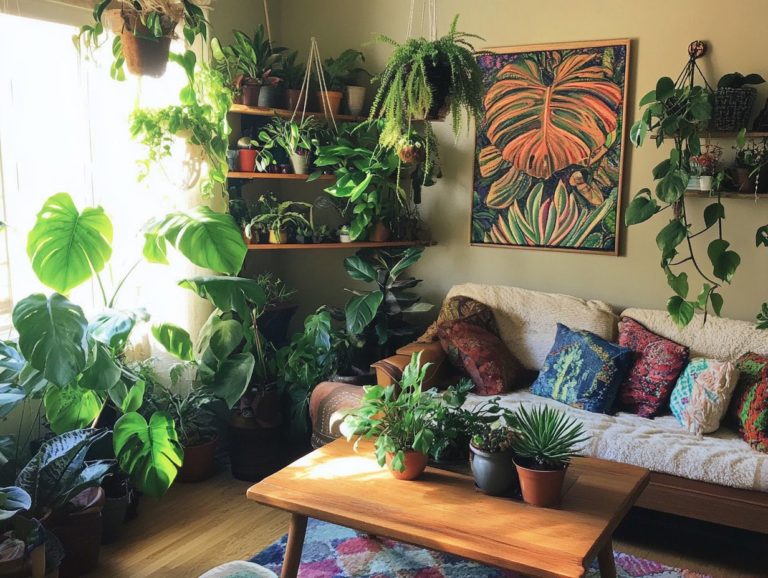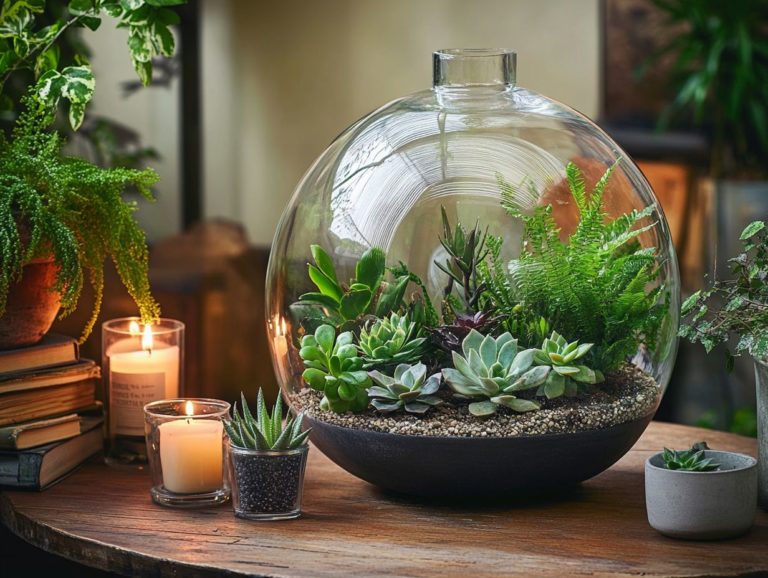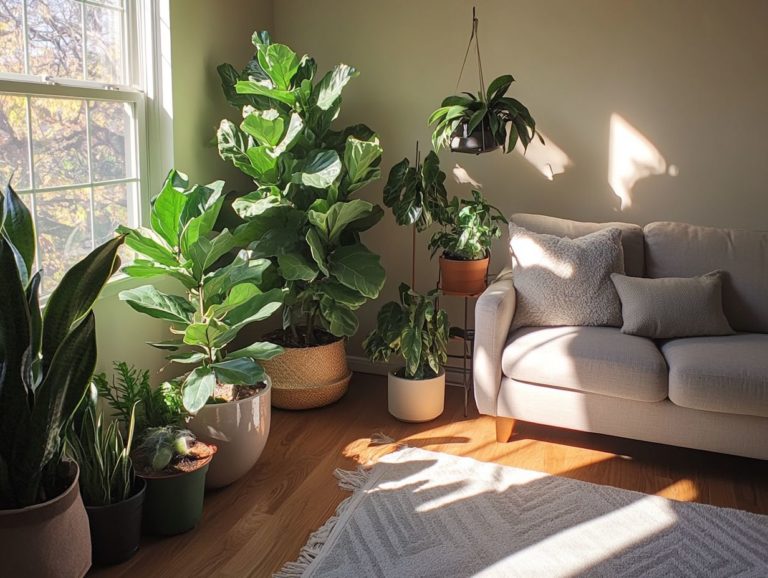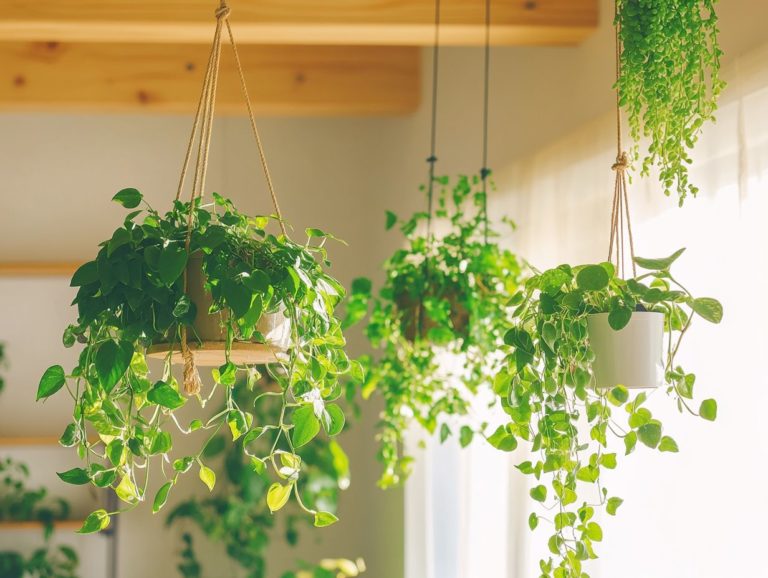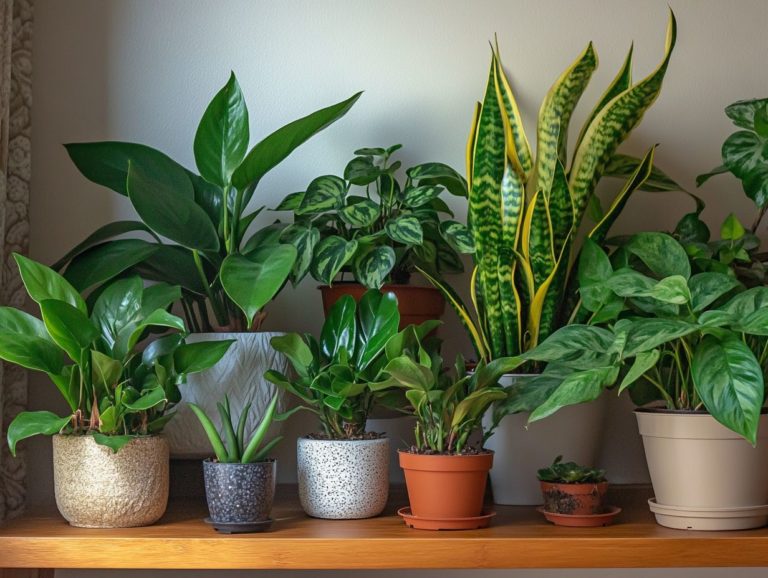DIY Plant Shelves for Your Indoor Garden
Transforming your indoor space with vibrant greenery is more attainable than you might believe, especially with the allure of DIY plant shelves. This guide will lead you through every step, from gathering materials and crafting your shelves to decorating and arranging your plants with finesse.
Whether you aim to establish a striking focal point or simply optimize your available space, you’ll discover practical tips, budget-friendly ideas, and creative options tailored to your unique style. Prepare to cultivate your indoor garden and infuse life into your home!
Contents
- Key Takeaways:
- 1. Gather Materials and Tools
- 2. Measure and Cut Wood Pieces
- 3. Sand and Stain Wood Pieces
- 4. Assemble the Shelves
- 5. Mount the Shelves on the Wall
- 6. Add Hooks for Hanging Plants
- 7. Decorate and Arrange Plants
- 8. Tips for Maintaining Your Indoor Garden
- 9. Alternative Options for Plant Shelves
- 10. How to Make a Hanging Plant Shelf
- 11. Creative Ways to Use Plant Shelves in Your Home
- 12. Budget-Friendly DIY Plant Shelf Ideas
- 13. Incorporating Plant Shelves into Small Spaces
- 14. DIY Plant Shelf Ideas for Different Types of Plants
- 15. Final Thoughts and Inspiration for Your Indoor Garden
- Frequently Asked Questions
- What materials do I need to make DIY plant shelves for my indoor garden?
- Do I need any special tools or skills to build these shelves?
- How do I determine the ideal height for my plant shelves?
- Can I customize the size and design of my DIY plant shelves?
- Are there any safety precautions I should take when building my DIY plant shelves?
- How do I care for my DIY plant shelves and keep them looking good?
Key Takeaways:

- Create a budget-friendly DIY plant shelf using basic materials and tools for your indoor garden.
- Incorporate hanging plant shelves into small spaces for a unique touch.
- Use creative ways to decorate and arrange plants on your DIY plant shelves.
1. Gather Materials and Tools
To embark on your DIY journey of crafting a stunning wooden plant shelf, it’s essential for you to gather the right materials and tools. Not only will they support your indoor plants, but they’ll also enhance your home decor with a stylish display of greenery.
Consider using materials like reclaimed pine, cedar, or bamboo. These choices are not only durable but also eco-friendly, contributing to sustainability in your home. You ll need sturdy screws to hold everything together, along with a type of saw used for making precise angled cuts, a drill for effortless assembly, and sandpaper with larger particles for rough surfaces to achieve a smooth finish.
By utilizing eco-conscious finishes, you can further elevate the visual appeal of your plant oasis, turning it into a stunning feature in your living space while promoting a healthier environment with eco-friendly decor.
2. Measure and Cut Wood Pieces
Accurate measurements and precise cuts are essential steps in your DIY project to create a plant stand or floating shelves that will elegantly showcase your indoor plants. Taking the time to measure each piece of wood meticulously ensures that everything aligns perfectly during assembly.
Utilizing tools like a miter saw or a table saw significantly enhances the accuracy of your cuts, allowing for clean edges that provide a snug fit. Using a measuring tape and square to mark your cuts will help you minimize errors that could compromise the overall integrity of your design.
Keep in mind that precision isn t just about aesthetics; it s vital for crafting a sturdy structure that can support the weight of your plants without wobbling. Incorporating techniques such as dry fitting all the pieces before final assembly can further ensure a seamless finish, elevating your project to the next level.
3. Sand and Stain Wood Pieces
Sanding and staining your wood pieces is essential for achieving a smooth finish while enhancing the beauty of your decorative shelf. This makes it a stunning addition to your indoor gardening space with ideas for geometric design.
To achieve optimal results, start the sanding process with coarser grit sandpaper to eliminate any rough patches or imperfections on your decorative shelf. As you transition to finer grits, you ll notice the wood becoming increasingly smooth, resulting in a refined and elegant look. An electric sander can speed up this process, but hand sanding provides the precision you need for those intricate contours.
Once you re pleased with the smoothness, it s time to choose a stain that not only complements the wood’s natural grain but also harmonizes with the plants that will grace your shelf. The range of stains from light honey tones to deep mahogany can significantly influence the overall aesthetic, playing a crucial role in enhancing the colors and textures of your indoor plants and their arrangement.
Don t wait! Start crafting your own plant shelves today, and be sure to share your DIY plant shelf pictures or ideas after following this guide!
4. Assemble the Shelves
Assemble your wooden plant shelf with care. Create a sturdy structure that supports your plants while enhancing your indoor oasis.
Select the right joining techniques. Wood glue and dowels give a seamless finish, while screws offer added security. Choose durable wood like pine or oak.
Evaluate the weight and size of your plants. This impacts the shelf dimensions and anchoring methods.
Reinforce the structure to prevent mishaps. This ensures your greenery flourishes safely and beautifully.
5. Mount the Shelves on the Wall
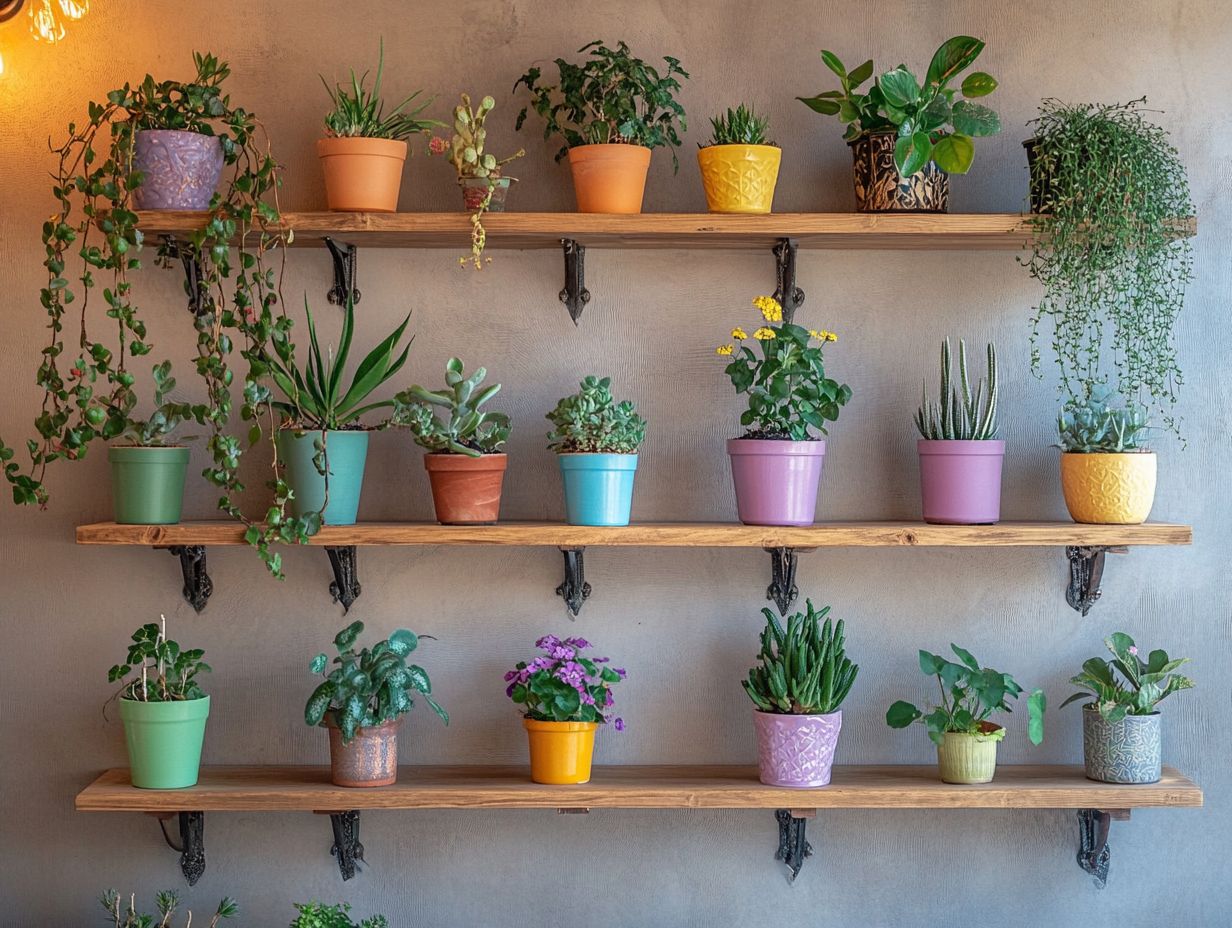
Mounting your shelves on the wall is essential for showcasing your indoor greenery while utilizing vertical space.
Get ready to gather your tools! Use a level, drill, measuring tape, and a stud finder to locate the most stable areas on your wall for the perfect plant arrangement.
Select the right wall anchors. They provide the necessary support for your heavier items.
Follow a clear plan to check weight capacities and distribute the load evenly. Always take safety precautions wear goggles and keep the area clear.
6. Add Hooks for Hanging Plants
Add hooks for hanging plants to elevate your display. This showcases trailing houseplants and air plants beautifully.
Explore different types of hooks ceiling hooks, wall-mounted brackets, and macram hangers to create a stunning botanical display.
Consider plants like pothos and Tillandsia. They thrive in hanging arrangements and enhance your decor.
Pothos, with its lush trailing vines, softens the edges of shelves. Air plants introduce a whimsical touch wherever they are placed.
With thoughtful installation and plant choices, you can create a personal oasis that seamlessly blends nature with style.
7. Decorate and Arrange Plants
Decorating and arranging your plants presents an exciting opportunity to unleash your creativity and craft a display that reflects your personality.
To achieve a stunning arrangement, vary the heights of your plants. Use taller varieties, like snake plants or fiddle leaf figs, as anchors, while medium-sized plants like pothos or rubber plants add fullness.
On lower shelves, lush trailing plants or compact succulents create an inviting ambiance. Remember, cohesive color coordination enhances your overall aesthetic.
Consider specific decor themes that complement your plant arrangements, such as bohemian or minimalist styles, to elevate your space even further.
Implementing a plant wall or curating a plant oasis can dramatically transform your area, providing a serene atmosphere that breathes life into any room.
8. Tips for Maintaining Your Indoor Garden
Maintaining your indoor garden requires thoughtful plant care and a solid understanding of indoor gardening techniques. This helps your plants thrive and brings beauty to your home.
Understanding the unique needs of each plant is crucial. For instance, tropical plants need more humidity and bright, indirect light. In contrast, herbs like basil and mint flourish in direct sunlight, making them excellent choices for your herb garden.
Regular watering is essential, but different plants have different needs. Cacti and succulents prefer drier soil, while ferns thrive in consistently moist conditions, which is vital for a healthy indoor garden.
When it comes to fertilization, timing is everything. During spring and summer, many plants benefit from a balanced liquid fertilizer that encourages growth. In contrast, dormant plants in the fall and winter might not need any fertilizer at all.
By tailoring your care routines to these specific needs, you can create a flourishing indoor ecosystem that enhances your space.
9. Alternative Options for Plant Shelves
If you’re looking for alternative options for plant shelves, consider versatile shelving solutions like an Ikea bookcase or wall-mounted shelves. These options blend functionality and style to meet your indoor gardening needs.
These choices provide ample space for your diverse collection of plants and serve as stylish decor elements that elevate your room’s aesthetic. Many store-bought options come with easy-to-install features, ensuring quick access to your plants for watering and pruning.
If you prefer DIY projects, you can infuse your personality into your shelving by customizing designs to fit your unique spaces and tastes.
Imagine crafting a rustic ladder shelf from reclaimed wood or incorporating geometric designs to display your plants in a modern way. Each approach adds its own charm while supporting your indoor gardening ambitions.
10. How to Make a Hanging Plant Shelf
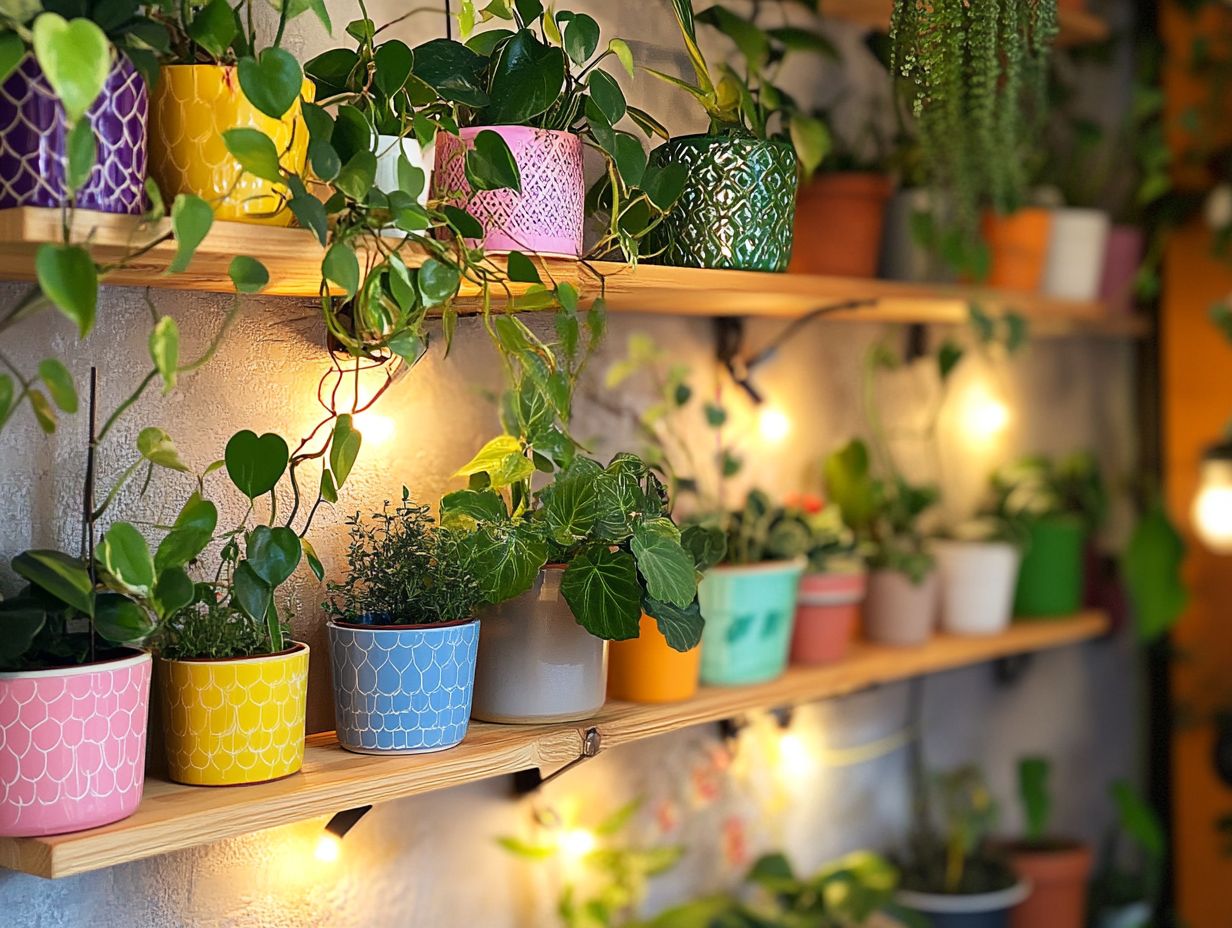
Making a hanging plant shelf is a fun and creative DIY project that brings life to your space with minimal effort.
By thoughtfully choosing the right materials and techniques, you can ensure that your shelf is both stylish and structurally sound. Start by gathering materials such as sturdy wood, supportive brackets, and a strong rope or chain for hanging.
Measure your desired height, attach the brackets to the wall securely, and properly affix the shelf.
For a modern aesthetic, consider opting for minimalistic designs or incorporating geometric shapes. For plants, trailing varieties like pothos or string of hearts are perfect contenders; their elegant cascades will enhance the overall vibe of your space.
11. Creative Ways to Use Plant Shelves in Your Home
Exploring creative ways to incorporate plant shelves into your home can elevate your indoor gardening experience, transforming ordinary spaces into vibrant displays that embody modern and minimalist aesthetics.
Combine unique art pieces, cherished books, and decorative objects to craft a stunning visual narrative. Picture a lush shelf adorned with trailing vines, elegantly paired with a striking photograph in a stylish frame or a thoughtfully placed sculpture that captures attention.
This strategy not only optimizes vertical space but infuses character into both cozy corners and expansive walls. The harmonious relationship between greenery and curated decor can revitalize any area, inviting a sense of tranquility and inspiration throughout your home.
12. Budget-Friendly DIY Plant Shelf Ideas
Creating budget-friendly DIY plant shelf ideas allows you to cultivate your dream indoor garden without straining your finances. With simple projects that can be tackled over a weekend, you can unleash your creativity and transform everyday materials into stunning decor that enhances your home while showcasing your green treasures.
Consider repurposing reclaimed wood pallets into rustic shelves or stacking and painting old crates to introduce a vibrant splash of color. Using straightforward brackets or giving old furniture a new lease on life can turn a bare wall into a lively plant display.
These innovative designs not only save you money but also infuse a personal touch into your space. With a dash of imagination, you ll find that stylish and economical plant shelves are not just a dream they re entirely within your reach.
13. Incorporating Plant Shelves into Small Spaces
Incorporating plant shelves into your small space is a brilliant way to maximize every inch while transforming your home into a vibrant indoor oasis brimming with greenery and life.
Take advantage of vertical space to introduce a delightful variety of plants without sacrificing precious floor area. For example, trailing plants like pothos or string of hearts can elegantly cascade down from higher shelves, adding a dramatic flair to your surroundings.
Pair larger leafy plants, such as a snake plant or ZZ plant, on lower shelves to create visual balance while significantly enhancing your air quality.
Arrange plants in groups of varying heights to draw the eye upward and form an engaging focal point that livens up the room. Select the right mix of plants and be mindful of their light requirements to curate a thriving and aesthetically pleasing display that elevates the charm of your compact living area.
14. DIY Plant Shelf Ideas for Different Types of Plants
Exploring DIY plant shelf ideas tailored for different types of plants gives you the power to customize your indoor gardening setup to meet the unique needs of your houseplants while elevating your home decor.
Investing time in designing your shelves based on the specific requirements of each plant variety helps create a space that is not only functional but also visually stunning inviting a touch of greenery into your home.
Imagine constructing a multi-tiered shelf that bathes your succulents in ample sunlight, which they love.
A wider, lower shelf could be perfect for your tropical plants, which helps maintain the humidity they need and makes misting a breeze.
If you re leaning toward herb gardens, consider incorporating small pots with drainage holes to encourage healthy growth while preventing overwatering. This setup will also ensure easy access for your daily harvesting needs.
15. Final Thoughts and Inspiration for Your Indoor Garden

Your journey into indoor gardening can truly inspire you to create a personalized oasis that reflects your unique style while fostering a deep appreciation for plant care.
By incorporating a diverse array of plants from vibrant succulents to lush ferns you can craft an enchanting atmosphere that delights the senses and nourishes the soul.
Picture a cozy corner adorned with cascading vines or a sunlit shelf brimming with cheerful blooms, each playing a part in a beautiful dialogue between nature and your home.
The joy of indoor gardening isn’t just about nurturing different species; it s about witnessing how greenery can transform an ordinary space into a serene retreat.
Such environments can elevate your well-being, alleviate stress, and uplift your mood, providing the perfect backdrop for creativity and relaxation.
Frequently Asked Questions
What materials do I need to make DIY plant shelves for my indoor garden?
You will need wooden boards, screws, a drill, measuring tape, a level, and brackets to make your DIY plant shelves, perfect for any easy DIY project.
Do I need any special tools or skills to build these shelves?
No, you do not need any special tools or skills. Basic woodworking tools and a basic knowledge of using a drill will be sufficient for this simple project.
How do I determine the ideal height for my plant shelves?
The height of your plant shelves depends on the tallest plant you want to display. Measure that height and add a few extra inches for a perfect fit.
Can I customize the size and design of my DIY plant shelves?
Absolutely! You can change the size and look of your shelves to match your space and style. Just remember to measure carefully before you start building.
Are there any safety precautions I should take when building my DIY plant shelves?
Yes! Wear safety goggles and gloves while using tools to protect yourself. Also, ensure your shelves are firmly attached to the wall to avoid accidents.
How do I care for my DIY plant shelves and keep them looking good?
Keep your shelves neat by dusting them regularly and wiping them with a damp cloth. If the wood looks dry, apply some wood polish or oil to bring back its shine.

